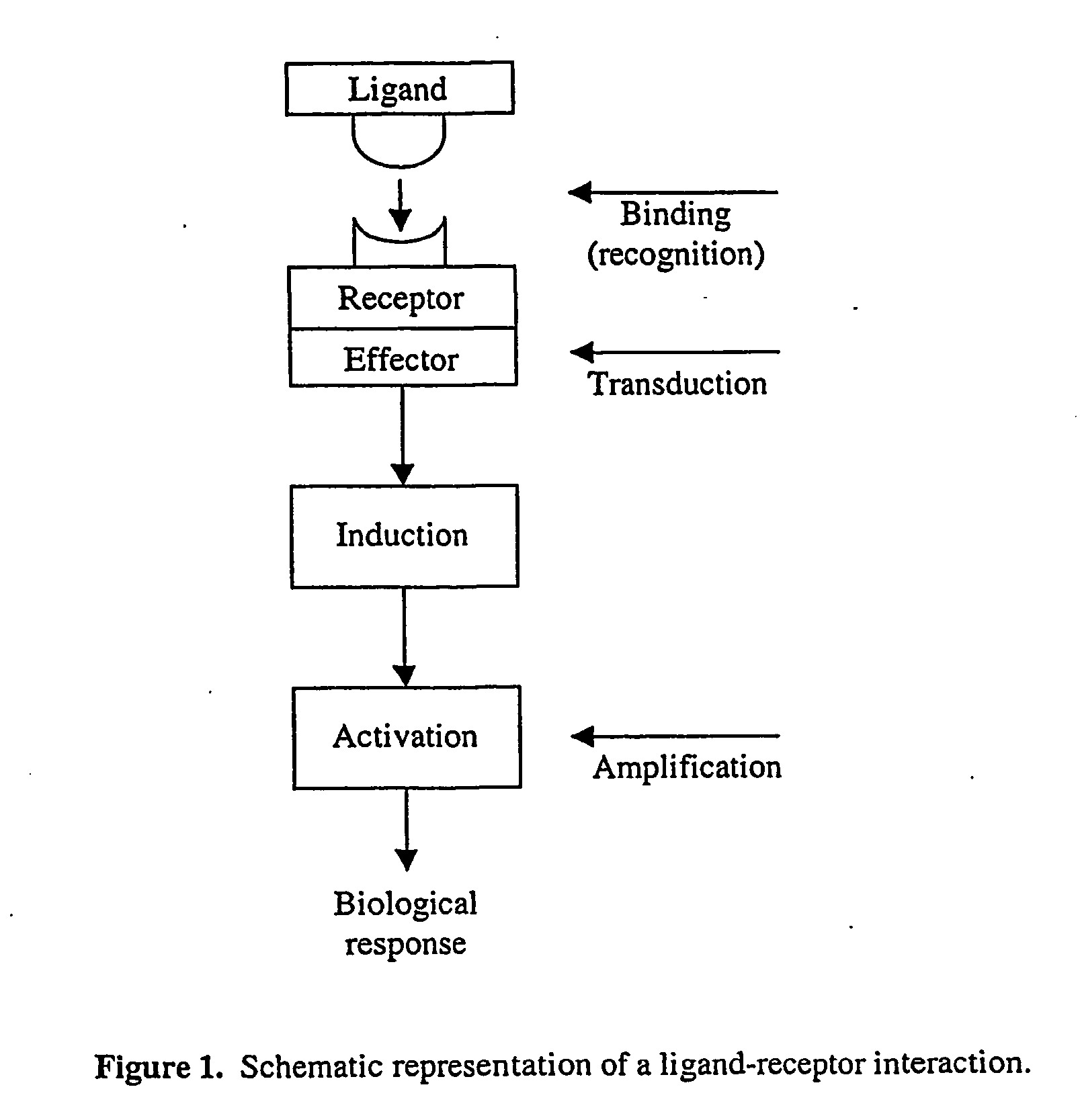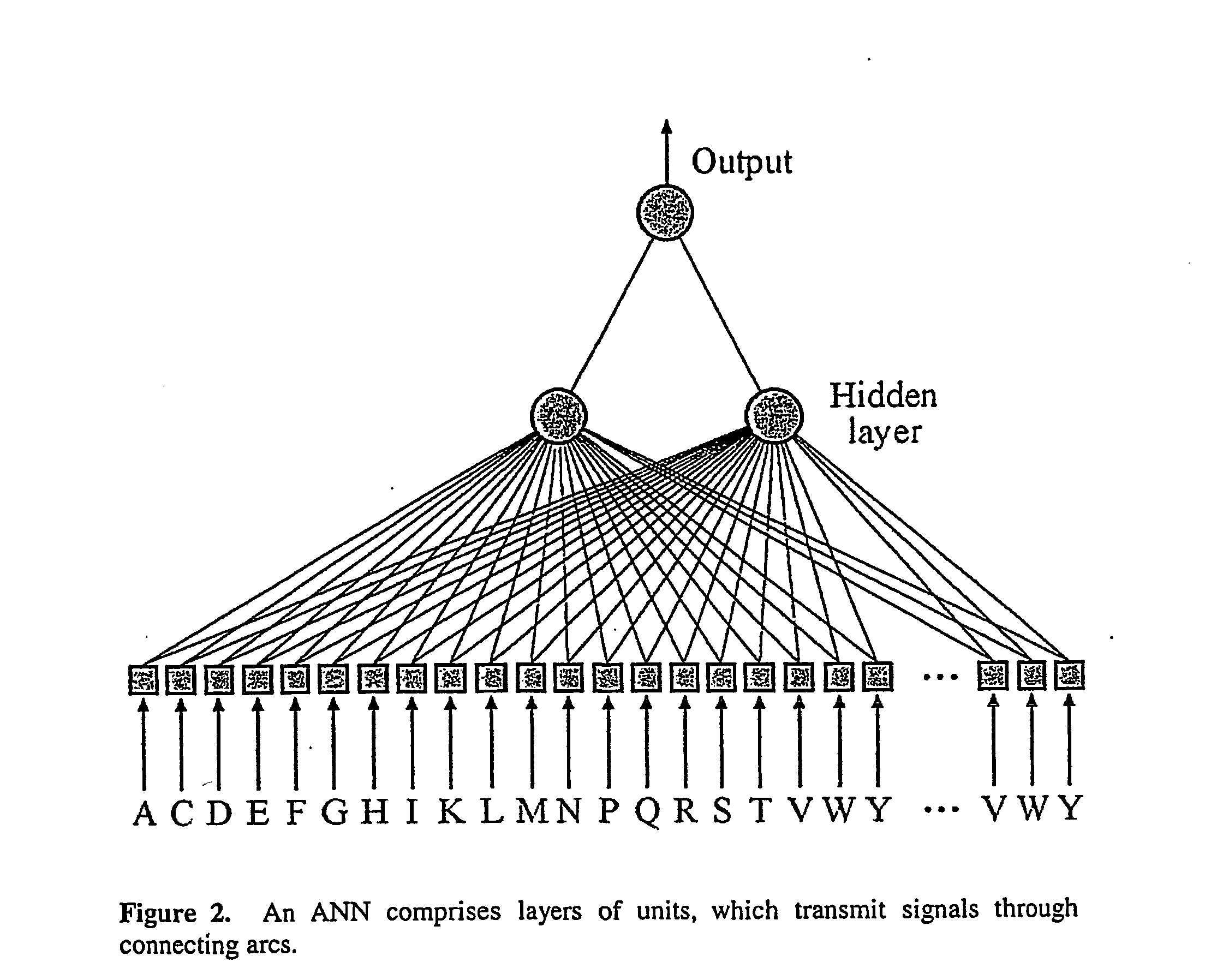System and method for systematic prediction of ligand/receptor activity
a technology of ligand/receptor activity and systematic identification, applied in the field of system and method for systematic identification and prediction of ligand/receptor activity, can solve the problems of inability to screen a family of receptors for their ligands, inability to systematic laboratory approach to t-cell epitope mapping, even of a single protein antigen, and inability to achieve large-scale screening. , to achieve the effect of convenient use of a single model
- Summary
- Abstract
- Description
- Claims
- Application Information
AI Technical Summary
Benefits of technology
Problems solved by technology
Method used
Image
Examples
example 1
Peptide PLWGPRALV of the mage-3 antigen (SWISSPROT:MAG3_HUMAN) binds HLA-A*0201 molecule (Kawakami Y. and Rosenberg S.A. (1996) “T-cell recognition of self peptides as tumour rejection antigens”, Immunologic Research 15, 179-190). The interaction site of the peptide with the cleft of the HLA-A*0201 molecule is the whole length of the peptide. The positional binding environments of peptides have been resolved by crystallography (Bjorkman P. J., Saper M. A., Samraoui B., Bennett W. S., Strominger J. L., Wiley D. C. (1987), “Structure of the human class I histocompatibility antigen, HLA-A2”, Nature 329, 506-512). The HLA-A peptide residue positional environments are summarised in Table 1. The process of obtaining the representation of the interaction of the said peptide and said receptor is shown in FIG. 5. HLA-A*0201 has 48 contact amino acids on the surface of the binding groove that constitute peptide interaction site (FIG. 5A). Removing non-contact amino acids (FIG. 5B) and concat...
example 2
Peptide PKPPKPVSKMRMATPLLMQALPMG of class II invariant chain (SwissProt Acc. P04233) binds HLA-DRB1*0101 molecule (Chicz R. M., Urban R. G., Gorga J. C., Vignali D. A., Lane W. S. and Strominger J L. (1993) “Specificity and promiscuity among naturally processed peptides bound to HLA-DR alleles”, Journal of Experimental Medicine 178, 27-47). The interaction site of the peptide with the cleft of the HLA-DR1(DRB1*0101) molecule is the 9-mer binding core (MATPLLM).
The positional binding environments of peptides have been resolved by crystallography (Stern L. J., Brown J. H., Jardetzky T. S., Gorga J. C., Urban R. G., Strominger J. L., Wiley D. C. (1994), “Crystal structure of the human class II MHC protein HLA-DR1 complexed with an influenza virus peptide”, Nature 368, 215-221). The HLA-DR peptide residue positional environments are summarised in Table 2. The process of obtaining the representation of the said peptide and the said receptor is shown in FIG. 7. HLA-DR1(0101) is a dimer...
example 3
Binding affinity of a number of peptides have been measured for eight HLA-DR molecules DR1, DR3, DR4, DR7, DR8, DR11, DR13, and DR15 (Table 4). Binding cores of the peptides have been determined by using binding motifs (Rammensee H., Bachmann J., Emmerich N. P., Bachor O. A. and Stevanovic S. (1999), “SYFPEITHI: database for MHC ligands and peptide motifs”, Immunogenetics 50, 213-219) or matrix methods (Brusic V., Zeleznikow J., Sturniolo T., Bono E. and Hammer J. (1999), “Data cleansing for computer models: a case study from immunology”, Proceedings of ICONIP99, The sixth International Conference on Neural Information Processing, IEEE, 603-609). The representation of the receptor interaction sites for the beta chains of eight HLA-DR molecules is given in FIG. 10. The alpha chain is identical for the eight HLA-DR molecules (see FIG. 8). The representation of the receptor interaction sites for the eight HLA-DR molecules is given in FIG. 11. Constant amino acids provide no basis for ...
PUM
 Login to View More
Login to View More Abstract
Description
Claims
Application Information
 Login to View More
Login to View More - R&D
- Intellectual Property
- Life Sciences
- Materials
- Tech Scout
- Unparalleled Data Quality
- Higher Quality Content
- 60% Fewer Hallucinations
Browse by: Latest US Patents, China's latest patents, Technical Efficacy Thesaurus, Application Domain, Technology Topic, Popular Technical Reports.
© 2025 PatSnap. All rights reserved.Legal|Privacy policy|Modern Slavery Act Transparency Statement|Sitemap|About US| Contact US: help@patsnap.com



